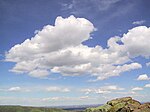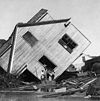
Back بوابة:طقس Arabic دەروازە:کەش و ھەوا CKB Portál:Meteorologie Czech Portal:Wetter und Klima German Portail:Météorologie French Portale:Meteorologia Italian Portal:気象と気候 Japanese 포털:날씨 Korean Portāls:Meteoroloģija Latvian/Lettish Portal:Pogoda Polish
The weather portal
Weather is the state of the atmosphere, describing for example the degree to which it is hot or cold, wet or dry, calm or stormy, clear or cloudy. On Earth, most weather phenomena occur in the lowest layer of the planet's atmosphere, the troposphere, just below the stratosphere. Weather refers to day-to-day temperature, precipitation, and other atmospheric conditions, whereas climate is the term for the averaging of atmospheric conditions over longer periods of time. When used without qualification, "weather" is generally understood to mean the weather of Earth.
Weather is driven by air pressure, temperature, and moisture differences between one place and another. These differences can occur due to the Sun's angle at any particular spot, which varies with latitude. The strong temperature contrast between polar and tropical air gives rise to the largest scale atmospheric circulations: the Hadley cell, the Ferrel cell, the polar cell, and the jet stream. Weather systems in the middle latitudes, such as extratropical cyclones, are caused by instabilities of the jet streamflow. Because Earth's axis is tilted relative to its orbital plane (called the ecliptic), sunlight is incident at different angles at different times of the year. On Earth's surface, temperatures usually range ±40 °C (−40 °F to 104 °F) annually. Over thousands of years, changes in Earth's orbit can affect the amount and distribution of solar energy received by Earth, thus influencing long-term climate and global climate change.
Surface temperature differences in turn cause pressure differences. Higher altitudes are cooler than lower altitudes, as most atmospheric heating is due to contact with the Earth's surface while radiative losses to space are mostly constant. Weather forecasting is the application of science and technology to predict the state of the atmosphere for a future time and a given location. Earth's weather system is a chaotic system; as a result, small changes to one part of the system can grow to have large effects on the system as a whole. Human attempts to control the weather have occurred throughout history, and there is evidence that human activities such as agriculture and industry have modified weather patterns.
Studying how the weather works on other planets has been helpful in understanding how weather works on Earth. A famous landmark in the Solar System, Jupiter's Great Red Spot, is an anticyclonic storm known to have existed for at least 300 years. However, the weather is not limited to planetary bodies. A star's corona is constantly being lost to space, creating what is essentially a very thin atmosphere throughout the Solar System. The movement of mass ejected from the Sun is known as the solar wind. (Full article...)
Selected article
Snow events are a rarity in the U.S. state of Florida, as freezing temperatures in the state are generally caused by the cold and dry winds of anticyclones. Most of the state is in a rare portion of the continental United States which receives a mean maximum monthly snowfall amount of zero, the only other such areas being southern Texas and California. However, snow does occur, especially in the northern interior sections of the state, sometimes more than once in a season. Areas near Jacksonville have seen several inches of snow on occasion, and snow flurries have been reported as far south as Homestead. Generally, for snow to occur, the polar jet stream must move southward through Texas and into the Gulf of Mexico, with a stalled cold front across the southern portion of the state curving northeastward to combine freezing air into the frontal clouds.

Recently selected articles: Great Lakes Storm, Extratropical cyclone, More...
Did you know (auto-generated) -

- ... that Eric Berger wrote about weather for the Houston Chronicle even before he became a certified meteorologist?
- ... that in the 1980s, "Sherman Bonner, The Human Thermometer" presented the weather on an Arkansas TV station?
- ... that weather whiplash is the phenomenon of rapid swings between extremes of weather conditions?
- ... that Japanese actor Kouhei Higuchi prepared for his role on the television drama adaptation of My Personal Weatherman by learning from a weather forecaster?
- ... that the weather forecast for HD 189733 b is "Westerly winds at 2000 m/s, with molten glass showers"?
- ... that after Irish post office clerk Maureen Flavin Sweeney reported worsening weather conditions, Dwight D. Eisenhower agreed to postpone D-Day by 24 hours?
Selected image

Two sun dogs, also known as "mock suns", appear to the left and right of the sun outside of New Ulm, Minnesota, United States. Sun dogs are an optical phenomenon caused by ice crystals either suspended near the surface during cold weather or in high clouds.
Recently selected pictures: Pyrocumulus clouds, Cloud-to-cloud lightning, Eye of Hurricane Isabel, More...
More did you know...
...that the Flying river is the name given to the transport of water vapor from the Amazon rainforest to southern Brazil?
...that hurricane shutters are required for all homes in Florida unless impact-resistant glass is used?
...that the Joint Institute for Marine and Atmospheric Research is a combined weather and ocean research institute with the cooperation of the Office of Oceanic and Atmospheric Research and the University of Hawaiʻi?
...that the SS Central America was sunk by a hurricane while carrying more than 30,000 pounds (13,600 kg) of gold, contributing to the Panic of 1857?
...that a hurricane force wind warning is issued by the United States National Weather Service for storms that are not tropical cyclones but are expected to produce hurricane-force winds (65 knots (75 mph; 120 km/h) or higher)?
...that the Automated Tropical Cyclone Forecasting System is a software package for tropical cyclone forecasting developed in 1988 that is still used today by meteorologists in various branches of the US Government?
Recent and ongoing weather
- Wikinews weather portal
- March 26, 2021: Tropical moisture ceases to cause severe floods in South East Australia
- February 19, 2021: Winter storms hammer Texas, fatalities reported
- December 28, 2021: Typhoon Phanfone strikes Philippines
- February 1, 2022: Deadly floods in Brazil after heavy rainfall
- April 15, 2022: South African floods kill at least 300 people
- Weather of 2024
- 2024 Atlantic hurricane season
- 2020–21 North American winter
- 2024 Pacific typhoon season
- Tornadoes of 2024
This week in weather history...
July 1
1992: The national meteorological service of New Zealand, known as the MetService, was established as a state-owned enterprise.
July 2
1965: TIROS-10, the final weather satellite of the original TIROS program, was launched from Cape Canaveral Air Force Station, Florida.
July 3
1996: Tropical Storm Cristina made landfall near Puerto Ángel, the third tropical cyclone to strike southern Mexico in 10 days.
July 4
1999: A severe derecho produced 90 miles per hour (145 km/h) winds that downed 25 million trees in the Boundary Waters Canoe Area Wilderness of northeastern Minnesota.
July 5
1805: Robert FitzRoy, captain of the HMS Beagle and a pioneering British meteorologist, was born in Suffolk, England.
July 6
2013: Hurricane Erick reached peak intensity as it passed 100 miles (160 km) offshore of Lázaro Cárdenas, Michoacán, Mexico. Though the storm did not make landfall, flooding rains lead to the deaths of at least two people.
July 7
1991: A major derecho raced from South Dakota to New York, killing one person and causing over $100 million in damage.
Selected biography
Vilhelm Friman Koren Bjerknes ForMemRS (/ˈbjɜːrknɪs/ BYURK-niss, Norwegian: [ˈbjæ̂rkneːs]; 14 March 1862 – 9 April 1951) was a Norwegian physicist and meteorologist who did much to found the modern practice of weather forecasting. He formulated the primitive equations that are still in use in numerical weather prediction and climate modeling, and he developed the so-called Bergen School of Meteorology, which was successful in advancing weather prediction and meteorology in the early 20th century. (Full article...)
Previously selected biographies: Anders Celsius, Robert FitzRoy, More...
Related portals
Quality content
Other candidates:
- Featured Article Review: 2005 Atlantic hurricane season (Discussion)
- Featured List Removal Candidate: List of storms in the 2005 Atlantic hurricane season (Discussion)
Subcategories
WikiProjects
The scope of WikiProject Weather is to have a single location for all weather-related articles on Wikipedia.
WikiProject Meteorology is a collaborative effort by dozens of Wikipedians to improve the quality of meteorology- and weather-related articles. If you would like to help, visit the project talk page, and see what needs doing.
WikiProject Severe weather is a similar project specific to articles about severe weather. Their talk page is located here.
WikiProject Tropical cyclones is a daughter project of WikiProject meteorology. The dozens of semi-active members and several full-time members focus on improving Wikipedia's coverage of tropical cyclones.
WikiProject Non-tropical storms is a collaborative project to improve articles related to winter storms, wind storms, and extratropical cyclones.
Wikipedia is a fully collaborative effort by volunteers. So if you see something you think you can improve, be bold and get to editing! We appreciate any help you can provide!
Associated Wikimedia
The following Wikimedia Foundation sister projects provide more on this subject:
-
Commons
Free media repository -
Wikibooks
Free textbooks and manuals -
Wikidata
Free knowledge base -
Wikinews
Free-content news -
Wikiquote
Collection of quotations -
Wikisource
Free-content library -
Wikiversity
Free learning tools -
Wiktionary
Dictionary and thesaurus
































